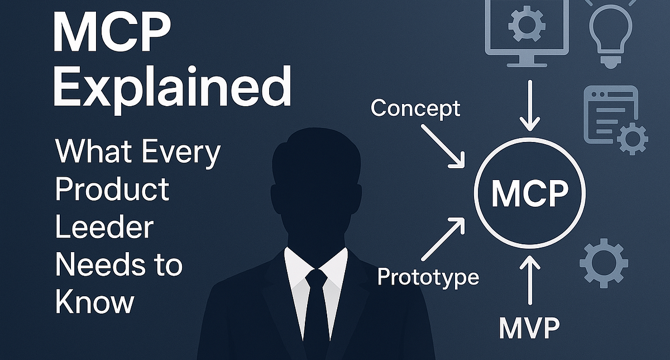Product Management News
Medium
355

Image Credit: Medium
They love numbers - not Data
- Many companies invest in data tools but struggle with low usage.
- Data is crucial for businesses, yet some companies still heavily rely on spreadsheets.
- Data is not just numbers; it is storytelling, consequence, prediction, and prevention.
- Data needs structure, business understanding, and careful evaluation to be meaningful.
- Every data point tells a story and should be evaluated in context.
- Product Managers need to understand the quality and purpose of data collected.
- Real-time data analysis can help uncover critical issues and prevent risks.
- Data is a necessity, not a luxury, and plays a vital role in decision-making.
- It is essential to prioritize obtaining real, relevant data for informed decisions.
Read Full Article
21 Likes
Medium
302
Image Credit: Medium
Why I’m Starting a 30-Day Manifestation Challenge?
- A 28-year-old Asian Product Manager from Taiwan is starting a 30-day manifestation challenge during her break from work post-surgery in February 2025.
- The surgery was a tough decision made for the sake of her health's sustainability.
- She found inspiration from 'manifestation diaries' on Threads where people share their journeys on goals like overseas job hunting or dieting.
- The challenge aims to help her heal through reflection, strengthen foreign language fluency, and build confidence.
- By recording her thoughts and perspectives consciously, she intends to explore and process her inner self during her in-between time.
- As a non-native language speaker, she wants to create her own space to improve speaking skills and develop a better sense of language.
- She aims to learn to appreciate and accept herself more, show up confidently in life and work, and overcome discomfort with the camera or listening to her voice.
- While she may not post daily, she plans to share 30 entries during the challenge to see the transformation that awaits at the end.
Read Full Article
18 Likes
Medium
355

Image Credit: Medium
Let the Data Breathe: Designing UI That Makes Visualizations Work
- Clear data visualizations are crucial for helping users make quick and confident decisions.
- The user interface plays a significant role in guiding attention, reducing friction, and enhancing the user experience.
- Designing UI for data-focused products is vital, as it impacts how users interact with the data.
- Layout, labeling, and interaction design choices are crucial for ensuring data usability and engagement.
- Key considerations include readability, appropriate type sizes, consistent alignment, clear labeling, and accessible tooltips.
- Color usage in visualizations should prioritize conveying meaning rather than being purely decorative.
- High-contrast color palettes support visibility and accessibility for all users.
- Testing visualizations in grayscale and with color blindness simulators can help ensure inclusivity.
Read Full Article
21 Likes
Medium
418

Image Credit: Medium
Do You Know Scrum Really? Explaining Complex Environments
- Agile Scrum is a popular framework in the tech world but often misunderstood in its true purpose.
- Scrum is not meant to be a one-size-fits-all process but is designed for complex, uncertain environments.
- It is tailored for situations where more is unknown than known, and plans need to evolve through rapid learning.
- Scrum is built for complexity, and misunderstanding its purpose might lead to misconceptions about Agile in general.
- Scrum is an Agile framework for managing work, facilitating adaptive solutions for complex problems.
- The official Scrum Guide describes it as a lightweight framework that helps teams generate value through adaptive solutions.
- In practice, Scrum involves working in short cycles (Sprints) to build increments of a product.
- Teams gather feedback continuously and adjust their course based on learning.
- Scrum is empirical, promoting learning by doing, inspecting results, and adapting next steps accordingly.
Read Full Article
25 Likes
Discover more
- Programming News
- Software News
- Web Design
- Devops News
- Open Source News
- Databases
- Cloud News
- Operating Systems News
- Agile Methodology News
- Computer Engineering
- Startup News
- Cryptocurrency News
- Technology News
- Blockchain News
- Data Science News
- AR News
- Apple News
- Cyber Security News
- Leadership News
- Gaming News
- Automobiles News
Medium
204

Image Credit: Medium
Product Notes by Sai — What Is Product Management, Really?
- Product management is about creating alignment across the team and not about having all the answers or working solo.
- Product managers ensure engineers, designers, analysts, marketers, and stakeholders move in the same direction.
- User empathy is essential in product management to solve the right problems for the right reasons.
- A powerful mental model introduced in the course is the 6 Ds, which represent overlapping and evolving phases.
- The 6 Ds are not linear phases but a rhythm in product management.
- The role of a product manager is dynamic and continuously evolving.
- Product management involves constant adaptation and evolution of products.
- The author aims to simplify product management concepts in their Concept Simplifier series.
- The next topic in the series will be Product Thinking.
- The author emphasizes learning and evolving in product management.
- Continuous learning and adaptation are essential in the field of product management.
Read Full Article
12 Likes
Medium
253

Image Credit: Medium
My MCP Musings- What Every Product Leader Needs to Know
- The article discusses the author's realization about the Model Context Protocol (MCP) and its potential impact on AI integrations.
- MCP aims to simplify the integrations of AI systems with external tools by creating a universal 'plug' system.
- Rather than building custom connectors for every AI-to-tool connection, MCP involves creating standardized connections through MCP servers.
- Implementing MCP can lead to significant improvements such as reduced response times and increased development productivity.
- One key benefit of MCP is the potential to avoid vendor lock-in by enabling easy switching between different AI providers.
- The article raises questions about security concerns with AI accessing multiple systems through MCP servers and the need for vulnerability protection.
- It also discusses the challenges of timing, change management, and potential drawbacks of adopting MCP in product development.
- The author contemplates whether MCP represents a revolutionary shift in AI integration or just an evolution in engineering practices with effective marketing.
- The article concludes with a call for insights from others who have implemented MCP and invites discussion on the strategic implications of this protocol.
- Overall, the article explores the transformative potential of MCP in reshaping product development, particularly in the realm of AI integrations.
Read Full Article
15 Likes
Medium
84
Image Credit: Medium
7 Online Side Hustles You Can Start with ₹0 in 2025 (And Make Serious Cash)”
- Creators in India are leveraging Instagram and YouTube Shorts to earn money through brand collabs and affiliate links, making ₹10K–₹50K monthly.
- Use free design tools like Canva or Kittl to create designs for products that can be sold on platforms like Redbubble or Teepublic for profit.
- Join wholesale groups on Telegram or Instagram, resell products through WhatsApp status, and earn profit without holding inventory.
- Freelance writing, blogging on Medium, or providing services on platforms like Fiverr can be lucrative for those with writing skills.
- Utilize free AI video editors to create reels or promos and offer editing services to small businesses or influencers for a fee.
- Game streaming on platforms like YouTube Shorts is popular, with many Indian gamers rapidly acquiring followers.
- Individuals knowledgeable about saving, mutual funds, or credit cards can offer budget planning or investment advice for a fee via Instagram or Google Meet.
Read Full Article
5 Likes
Medium
97

Image Credit: Medium
The Product Manager’s Playbook: Eight Skills That Define Success
- Exceptional product managers excel in core competencies that define successful product leadership, such as strategic thinking and market foresight.
- They anticipate market trends, identify gaps, and position products for long-term success.
- Communication is crucial for product managers who must translate between technical teams, business stakeholders, and end users.
- Effective communication involves inspiring action, influencing decisions, and fostering consensus among diverse stakeholders.
- Product managers lead by setting a clear vision, empowering team members, and cultivating collaborative cultures.
- Empathy is a vital asset for product managers to understand and advocate for user needs throughout the development process.
- Problem-solving is fundamental in product management, requiring systematic approaches and proactive solutions.
- Data-driven decision-making is essential, combining quantitative analysis and qualitative insights to inform strategic actions.
- Skilled negotiation and consensus-building are crucial for navigating complex dynamics and diverse stakeholder interests.
- Successful product managers drive innovation by executing ideas effectively and bridging visionary concepts with practical delivery.
Read Full Article
5 Likes
Medium
326

Image Credit: Medium
Why UX Design Has Moved Beyond the Frontend
- The shift in UX design has moved beyond just frontend to include structuring data for better user interaction and AI accessibility.
- Users now expect to find information quickly and easily by accessing well-structured data, leading to a need for improved UX design.
- Websites and apps relying on data without exposing it in usable ways risk being left behind by competitors who provide more accessible information.
- An example of this is seen in real estate search platforms that fail to understand detailed user preferences and provide inefficient search experiences.
- By enabling AI agents to access and comprehend data, platforms can enhance user experience by allowing for specific, detailed queries.
- Products and UX teams now need to prioritize structuring data for AI accessibility as a crucial aspect of design and functionality.
- Data structuring has transitioned from being solely a backend concern to becoming an essential UX consideration for meeting user expectations.
Read Full Article
19 Likes
Medium
396

Image Credit: Medium
Crafting Compelling Objectives & Key Results
- Crafting compelling Objectives and Key Results (OKRs) involves setting clear and inspirational Objectives paired with measurable Key Results.
- Objectives should be bold, aspirational, easy to remember, and have a clear deadline, while Key Results should be specific, outcome-focused, and tied to measurable benchmarks.
- Product OKRs should be horizontally aligned across functions like UX, engineering, marketing, and customer success to foster collaboration and avoid duplicate efforts.
- Drafting OKRs involves brainstorming high-impact Objectives and measurable Key Results, ensuring each is SMART (Specific, Measurable, Achievable, Relevant, Time-bound).
- Clear ownership, constant visibility, and regular feedback loops are essential for successful OKR implementation.
- The Jira team's successful use of OKRs involved running tactical experiments under each Key Result, demonstrating the importance of aligning OKRs with strategic vision.
- Deciding whether to reset or roll over OKRs at quarter-end depends on the achievement and alignment of each Key Result with current business realities.
- OKRs should be reviewed by executive sponsors or key business partners for validation and sign-off to ensure alignment with overall strategic goals.
- Missteps like vague or unmeasurable Key Results and lack of clear ownership can derail OKR success.
- Weaving OKRs into daily activities, displaying them visibly, and assigning clear ownership with regular check-ins are crucial for maintaining focus and accountability.
- The article emphasizes the importance of setting inspiring OKRs that tie back to real business impact and involve strategic alignment across different functions.
Read Full Article
23 Likes
Medium
329

Image Credit: Medium
The $500 Million Mistake: Why Over-Engineering Your Software Could Be Your Biggest Fail
- Over-engineering in software development often leads to expensive and problematic issues as developers focus on creating complex, future-proof solutions instead of addressing actual problems.
- Pressure for quick turnarounds can result in compromises, shortcuts, and inadequate testing, leading to solutions that fail in reality despite looking promising on paper.
- The United States government's $500 million Healthcare.gov project is a prime example of over-engineering, mismanagement, and misplaced priorities, leading to crashes, delays, and errors upon its launch in 2013.
- The project aimed at creating a complex system integrating multiple databases and insurance providers instead of focusing on a basic user interface to meet users' needs.
- Political pressure for deadlines resulted in cutting corners, reducing testing time, and involving too many agencies, leading to division of responsibility and poor decision-making.
- The failure of Healthcare.gov was attributed to over-engineering, mismanagement, and neglecting real user needs in favor of an exaggerated internal agenda focused on hypothetical problems.
- It's crucial not to lose sight of real issues by over-engineering projects with unnecessary features and hypothetical scenarios, as businesses need sustainable, quality solutions that address tangible problems.
- A key lesson is to start small, build iteratively, and prioritize solving real problems rather than getting distracted by hypotheticals and rushing to meet deadlines.
- Quality in software development takes time, and cutting corners to speed up the process can lead to higher costs and failures in the long run.
Read Full Article
19 Likes
Medium
400

Image Credit: Medium
Pixel Pioneers Bristol 2025 Speaker Spotlight: Rabeb Othmani
- Rabeb Othmani transitioned from software engineer to product manager organically, combining technical depth with storytelling and advocacy in Developer Relations.
- She is currently the Product Lead at the Interledger Foundation, focusing on Web Monetisation to promote financial equity through open-source technology.
- In her lightning talk at Pixel Pioneers Bristol 2025, Rabeb will introduce Web Monetisation's benefits and inclusivity in digital payments.
- She emphasizes the importance of diversity, inclusion, and courage in the tech industry, urging for active measures to promote justice and humanity.
- Rabeb shares her marathon experiences, including a memorable run in Cape Town, and her annual birthday run tradition.
- Her advice revolves around trusting oneself, believing in personal instincts, and combining them with hard work for success.
- Rabeb's talk at Pixel Pioneers Bristol 2025 will delve into Web Monetisation, alongside discussions on AI, web performance debugging, and web accessibility.
Read Full Article
24 Likes
Medium
80

Image Credit: Medium
Mastering Product Management for Ad‑Tech & UX‑Heavy Platforms: A Practical Guide
- This practical guide is tailored for product managers and team leads working in data-intensive advertising-technology (ad-tech) or UX-heavy SaaS platforms.
- Product management involves creating clarity from chaos, driving innovation, and delivering value to users.
- Effective strategies outlined in the guide enhance workflow, streamline team operations, and achieve sustainable project growth.
- Key points include dashboard as a command center, quarterly swimlanes for strategic roadmaps, systematic tagging structure for tasks, and leveraging quick filters.
- Team progress should be clarified with balanced updates on new features, bugs, and maintenance tasks.
- Recommended task allocation baseline is 60% for product features, 20% for maintenance, and 20% for bug fixes, adaptable based on workload distribution.
- Estimations using the S/M/L/XL method help simplify complexity assessment for tasks.
- Communication is crucial, with technical details residing in Confluence but stakeholder updates should be captivating and informative.
- Practical tools like spreadsheets aid in auditing workload distribution for future planning and productivity improvement.
- Effective dashboards, rituals, estimates, communications, and research laid out in the guide pave the way for successful product management.
Read Full Article
4 Likes
Medium
258

Image Credit: Medium
Here’s How I Got What You’ve Been Dreaming Of Since Years…
- The author appeals to readers' curiosity by claiming to have discovered what they have been seeking for years.
- The author emphasizes the desire for quick solutions and real-life stories over generic advice.
- Readers are more interested in personal experiences and unconventional approaches rather than traditional advice.
- The importance of engaging storytelling is highlighted to capture audience interest.
- The author discusses the impact of changing blog titles to reflect personal experiences rather than generic advice.
- Personal anecdotes and experimentation are valued more by audiences than standard content.
- The author emphasizes the significance of providing real solutions and shortcuts to readers.
- By focusing on user experience and real-life examples, engagement and retention can be improved in writing and product development.
- The approach of treating writing like a product and product development like storytelling is recommended for better audience connection.
- Encouragement is given to write in a relatable manner and to share experiences rather than appearing as a guru.
Read Full Article
15 Likes
Medium
209

Image Credit: Medium
Generative AI vs AI Assistants : What’s the Difference for a PM?
- In product planning meetings, people often refer to using 'AI' as a catch-all term, despite the nuanced differences between Generative AI and AI Assistants.
- Generative AI is compared to a creative partner that can create new content from scratch like text, images, or music, while AI Assistants are seen as hyper-organized colleagues that enhance existing workflows.
- Generative AI is like a junior designer, writer, and developer rolled into one, excelling at ideation and first drafts with guidance required for quality control.
- AI Assistants act as an operational backbone, making tasks faster and more accurate; they excel in task management, optimization, and automation.
- Generative AI creates new content, while AI Assistants enhance existing workflows, with different input styles and output quality.
- Combining both Generative AI and AI Assistants in the PM workflow can yield magical results, enhancing human insight.
- Starting small by mastering one tool from each category before expanding the toolkit is advised to maximize efficiency.
- The focus is on augmenting human insight, not replacing it, through the strategic use of AI tools in product management.
- The article emphasizes the importance of understanding and strategically using AI tools in the fast-paced tech world.
- Readers are encouraged to share their experiences with AI tools and participate in the ongoing AI Challenge series.
Read Full Article
12 Likes
For uninterrupted reading, download the app